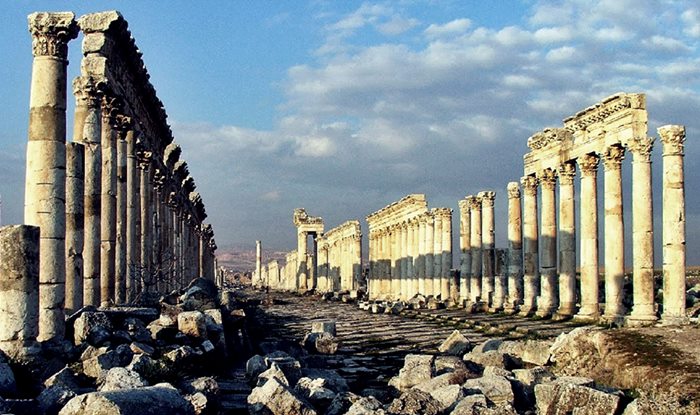
Battle of Apamea |
year: 99817 July 998 |
| A crashing defeat of the Byzantine army of Antioch by the Arabs | ★ ★ ★ ★ ★ |
|
enemy: Arabs (Fatimids)
|
location: Out of the Hellenistic and Byzantine city Apamea (on Orondes), near modern Qalaat al Madiq, in western Syria
|
accuracy:
●●●●●
|
|
battle type: Pitched Battle |
war: Later Byzantine-Muslim Wars |
modern country:
Syria |
| ▼ The Byzantines(emperor: Basil II Bulgaroktonos) | ▼ The Enemies | |
| Commander: | Duke of Antioch Damianos Dalassenos | Governor of Damascus Jaysh ibn Samsama |
| Forces: | 11,000 | |
| Losses: | thousands dead, 2,000 prisoners | more 2,000 dead |
| Background story: |
| In September 994, Michael Bourtzes, the Byzantine governor (doux– duke) of Antioch and northern Syria, suffered a heavy defeat at the Battle of the Orontes at the hands of the Fatimid general Manjutakin. This defeat posed a serious threat to the Arabic vassal of Byzantium, the Hamdanid Emirate of Aleppo. In order to protect it against the Fatimids, Emperor Basil II himself came down with his army in the region in 995, forcing Manjutakin to retreat to Damascus. After capturing Shayzar, Emesa (Homs), and Raphanea (Rafaniya), and building a new fortress at Tartus, the emperor withdrew, appointing a new duke in Antioch: Damianos Dalassenos. Dalassenos was active and effective in his mission to consolidate Byzantine power in the region. In 996 his forces raided the environs of Tripoli and Arqa, while Manjutakin, again without success, laid siege to Aleppo and Tartus, but was forced to withdraw when Dalassenos with his army intervened to relieve the fortress. The next year, Dalassenos repeated his raids against other castles of NW Syria. In early summer 998, Dalassenos learned that a catastrophic fire in Apamea had destroyed most of its provisions. Apamea was governed by a ruler who was under Fatimid control, and Dalassenos saw an opportunity to take the city. The Hamdanids of Aleppo had the same idea and arrived there first, but withdrew at the approach of Dalassenos, who could not permit a Muslim vassal to grow too strong; besides, being ambitious, he intended to capture the town for the emperor. Although the Hamdanids were allies of the Byzantines, they left the supplies they had brought with them to be collected by the inhabitants of Apamea, aiding them in their resistance. The people of Apamea asked for help from the Fatimids. The eunuch regent of the Fatimid Caliphate Barjawan appointed Jaysh ibn Samsama to command the relief army, naming him governor of Damascus and giving him 1000 men. After suppressing revolts in Tyre and Palestine (which the Byzantines failed to support) Jaysh ibn Samsama gathered an army in Damascus with troops and volunteers from other muslim principalities (Tripoli, Beirut, etc.) assembling a force of 10,000 Arabs and 1,000 Bedouin riders. Meanwhile, Dalassenos was vigorously pursuing the siege, and the inhabitants of Apamea had suffered from famine, being forced to eat cadavers and dogs, which they bought at outrageously high prices. |
The Battle: |
 Ruins of the Hellenistic Apamea At that point, a Kurdish rider rode towards Dalassenos, who was near his battle standard on top of a height and was accompanied only by two of his sons and 10 men of his retinue. Believing the battle was won and that the Kurd wanted to surrender, Dalassenos was not concerned. As he approached the Byzantine general, the Kurd suddenly charged. Dalassenos lifted his arm to shield himself, but the Kurd launched his spear at him. The general wore no helmet, and the blow killed him. Dalassenos' death changed the tide of the battle: the Fatimids took heart, regrouped and, shouting “the enemy of Allah is dead!”, turned on the Byzantines, who fell into panic and fled. The garrison of Apamea too sallied forth, completing the Byzantine debacle. The sources give various numbers for the Byzantine losses that number up to 10,000 dead. Most of the remaining Byzantines (2,000) were taken prisoner by the Fatimids. These included several senior officers and the two sons of Dalassenos, Constantine and Theophylactos, who were bought by Jaysh ibn Samsama for 6,000 dinars and spent the next 10 years as captives in Cairo. |
Aftermath: |
| The defeat forced Basil II to personally lead yet another campaign in Syria the following year. Arriving in Syria in mid-September, the emperor's army buried their fallen in the field of Apamea and then captured Shayzar, sacked the fortress of Masyaf and Rafaniya, torched Arqa, and raided the environs of Baalbek, Beirut, Tripoli and Jubayl. In mid-December, Basil returned to Antioch, where he installed Nikephoros Ouranos as duke. |
|
|
